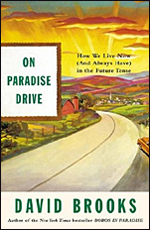"The mystical transubstantiation takes place in the venues of everyday life — at the magazine stand or on the train or in the doctor's office. Paging through ads is not a lofty or highly charged experience. Yet in these ordinary moments of life, the imagination is going about its business: measuring different futures, cooking up semiconscious fantasies, stoking the fires of anticipation, longing for different goods, homes, and lives, savoring the pleasures of fantasy.
"The key aspect to understand is that the imagination never rests. As cognitive scientists are discovering, the imagination is not some rarified gift that artists use to paint pictures. It's the brain at work every second of every day, blending one set of perceptions with others.
"When we pick up a cup of coffee, we experience many sensations: the smell, the color, the feel of the cup in our hand, the weight. These perceptions register in different parts of the brain. Somehow the brain blends them together. We have no idea how. This is imagination in its most rudimentary form: blending disparate sensations. At higher levels, the imagination blends what is with what could be. Without our permission, and without our ability to control it, our imagination takes physical sensations — me looking at a perfect kitchen in a glossy magazine-and it blends a fantasy landscape, me with my perfect family in the perfect kitchen and the dishes are clean and the meal was relaxed yet perfect.
"Imagination is slippery. It lives halfway in the world of physical reality and half in the realm of what isn't, what could be or never could be. In the realm of the imagination, it is very hard to draw a sensible distinction between the material and the nonmaterial. When we confront a new house, or a new car, or a new blouse, we see the physical object, but our imagination is racing ahead, concocting future pleasures and possibilities.
"Each of us has little templates in our minds, cognitive scientists have found, influenced by culture, genetics, and individual will, so certain products or goods set off those light shows in the imagination, while other products leave us cold. You may be aroused by the aroma of a certain wine or perhaps by the sight of a certain powerboat, depending on your background and tastes. But when a product or an image in a magazine hits the right ignition button, it is like July Fourth in the brain. The imagination goes wild. The longing begins. . . .
"Imagination is not only more important than we tend to admit, it is more double-edged. It tricks us into doing things that we probably shouldn't do, into wanting things we probably don't need. It is never content with the here and now. It is often the enemy, not the friend, of sober contemplation and quiet reflection. It's no accident that it is often the most imaginative people who lead the most disorganized lives.”
Back to reading a full review of this book.
